
Do you have a question about the Bernina Artista 170 and is the answer not in the manual?
| Stitch Count | 170 |
|---|---|
| Display | LCD |
| Memory | Yes |
| Bobbin System | Drop-in bobbin |
| Stitch Width | 7 mm |
| Stitch Length | 5 mm |
| Number of Stitches | 170 |
| Needle Stop Up/Down | Yes |
| Needle Threader | Automatic |
| Buttonhole Styles | Multiple |
| Speed Control | Yes |
Precautions to reduce the risk of electric shock when using the sewing computer.
Safety guidelines to prevent burns, fire, electric shock, or injury to persons.
Lists standard items for models 2MB (165) and 2MB/4MB.
Lists optional items for models 2MB (165) and 2MB/4MB.
Instructions on how to physically connect the embroidery module.
Instructions on how to detach the embroidery module.
Steps to attach the free arm adapter to the sewing computer.
Steps to connect the embroidery module to the adapter.
Instructions to detach the free arm adapter.
Essential steps: presser foot, needles, feed dog, threading.
Using straight stitch plate and thread stand.
Guidance on adjusting the upper thread tension.
Guidance on adjusting the bobbin thread tension.
Accessing module and card options for motif selection.
How to choose designs from the embroidery module.
How to choose designs from an inserted embroidery card.
Starting embroidery and switching between layout screens.
Adjusting color sequences and handling multi-color motifs.
Managing stitch sequence and sewing speed.
Saving motifs temporarily and setting the initial embroidery position.
Centering, checking size, altering size, and showing motifs.
Applying mirror image and rotation to motifs.
Moving motifs with arrows, hoop relocation, and temporary save.
Retrieving, deleting, and adjusting motif width and height.
Modifying stitch density and length for different threads.
Changing stitch types, e.g., long stitch to straight stitch.
Explanation of icons for presser foot, time, size, and hoop coding.
Descriptions of tear-away, cut-away, iron-on, water-soluble, and paper-backed stabilizers.
Guidance on choosing stabilizers for different fabrics and techniques.
Steps including centering, opening, template use, and securing fabric.
Steps before attaching the hoop, including needle position.
Instructions on how to physically attach the embroidery hoop.
Instructions on how to detach the embroidery hoop.
Initial steps for hoop adjustment, including module attachment.
Calibrating needle position to the hoop center.
Selecting, arranging, editing, and coloring letters.
Display and options on the sewing screen for motifs and letters.
Adjusting the orientation of letters for design.
Method for initiating embroidery using the head frame button.
Method for initiating embroidery using the foot pedal.
Handling color changes and thread management during sewing.
How to pause and restart the embroidery process.
Explanation of presser foot, design number, time, and size indicators.
Scrolling through and changing the color sequence of a motif.
Step-by-step process for manual color changes.
Bringing a moved motif back to its frame.
Positioning the hoop for the first stitch.
Locating and displaying the exact center of the motif.
Verifying hoop and motif size compatibility.
Reducing or enlarging motif dimensions.
Restoring a motif after size adjustments.
Flipping motifs horizontally for design.
Rotating motifs by specific degrees.
Restoring a motif after rotation.
Compressing or widening motifs horizontally.
Shortening or lengthening motifs vertically.
Restoring a motif after size adjustments.
Changing stitch types, e.g., long stitch to straight stitch.
Using straight stitch for fill patterns.
Using long stitch for fill patterns.
Choosing and preparing letters for combination.
Arranging, editing, and coloring letters on the screen.
Saving motifs temporarily in memory.
Managing and editing combined motifs.
Initial setup and insertion of the free-arm adapter.
Process for the machine to recognize the adapter.
Actions to take when the upper thread breaks or runs out.
Actions to take when the lower thread runs out.
Managing the stitch sequence after thread breakage.
How to restart embroidery after a thread break.
Descriptions of CPS, Artlink, and Artista embroidery software.
Details on small hoop, free arm adapter, and medium hoop.
Magic box, Reader/Writer box, and Embroidery cards.
Description of the multi spool thread stand.
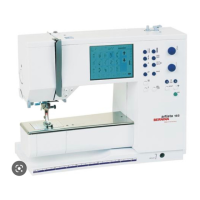
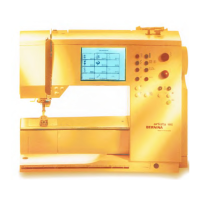
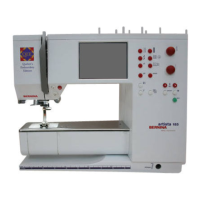
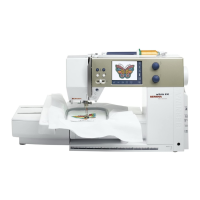
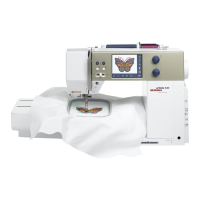
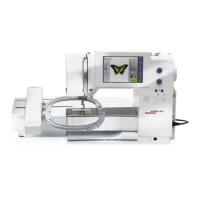

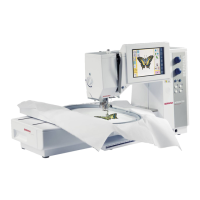
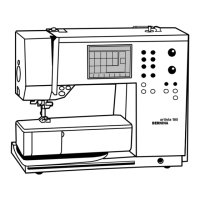
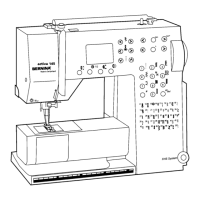

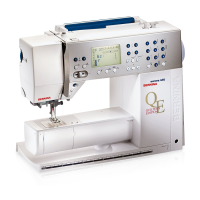
